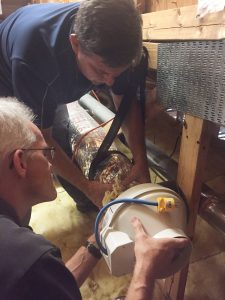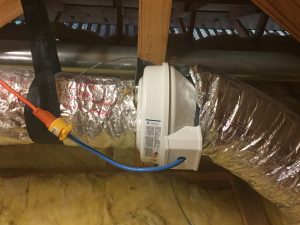By Jennifer Josey
National Renewable Energy Laboratory
February 22, 2018
How many times have you completed a system upgrade for a device only to find that it’s glitchy? No one wants to “upgrade” to downgrade, and we don’t like being inconvenienced as things get “smarter.” This is just as true for our homes. Reducing energy consumption (thereby saving money) is a key driver for smart, integrated tech (think smart thermostats); however, adoption is lower if an upgrade risks compromising resident comfort.
Whole-house, smart ventilation is one such up-and-coming “smart” technology. But before it takes off, there are a couple of hurdles to jump: integration with standard heating and cooling systems, and proving the risks are limited and the benefits are many. Researchers with the University of Central Florida’s Florida Solar Energy Center® (FSEC®), in partnership with Washington State University, are tackling smart ventilation systems head on.

In a first-of-its-kind report, “Field and Laboratory Testing of Approaches to Smart Whole-House Mechanical Ventilation Control,” FSEC documented research on lab and field testing of smart ventilation control (SVC) systems. The report explains that whole-house mechanical ventilation is a critical component to a comprehensive indoor air quality (IAQ) strategy. In addition, these systems can help the residential sector more reliably design, install, and operate mechanical ventilation systems to achieve best-practice IAQ while saving energy and improving comfort, moisture, and peak load impacts.
The Research
The report explores how smart ventilation controls can reduce heating and/or cooling loads, improve indoor moisture management, and maintain IAQ equivalence according to ASHRAE 62.2. With more than 25 years of ventilation research behind them and hundreds of related publications, FSEC experts investigated three SVC approaches:
- Seasonal-temperature-based
- Occupancy timer-based
- Real-time weather-based.
The research shows that by optimizing mechanical ventilation operations, SVCs can balance energy consumption, comfort, and IAQ. Even better, during time periods where energy, comfort, and/or IAQ are more easily maintained, the system increases ventilation, whereas it operates less when conditions are not as advantageous.
In addition, research shows that SVCs aren’t an all-or-nothing technology. As the day progresses and variables change (e.g., occupancy, outdoor temperature, and/or outdoor moisture), the mechanical ventilation operations can be controlled by the user and adjusted, as needed.
Vast Opportunities for SVC Technologies

For consumers, all this research is very good news. Smart vents could not only save energy and cash, but they can be just as comfortable indoors as before (but with less effort) and the very air they breathe will be healthier.
The research shows good news for developers and innovators as well. The potential market size for SVC is growing, clearly justifying the need for commercially available products. Market research shows the annual market for ventilation systems could be more than 650,000 homes per year, including new site-built code homes, new housing and urban development-code manufactured homes, and newly weatherized low-income units.
Only a small selection of smart ventilation systems is currently on the market. Commercially available calculators are just emerging that could help designers implement a simple SVC. To get there, a concerted commercialization effort is needed, and work is already underway. The FSEC team, for example, worked with manufacturers and other stakeholders to increase awareness of SVC potential, priming the industry for when these devices are developed and employed.
Download the full report to see the complete research results and conclusions.
Additional Resources
Access additional IAQ-related research from Building America Program teams by downloading the following publications:
- Measure Guideline: Ventilation Guidance for Residential High-Performance New Construction – Multifamily (2017)
- Comparative Performance of Two Ventilation Strategies in a Hot-Humid Climate (2017)
- Ventilation System Effectiveness and Tested Indoor Air Quality Impacts (2014)
- Comfort, Indoor Air Quality, and Energy Consumption in Low-Energy Homes (2013)
- Multifamily Ventilation Retrofit Strategies (2012).
This work was supported by the Building America Program within the U.S. Department of Energy Building Technologies Office.